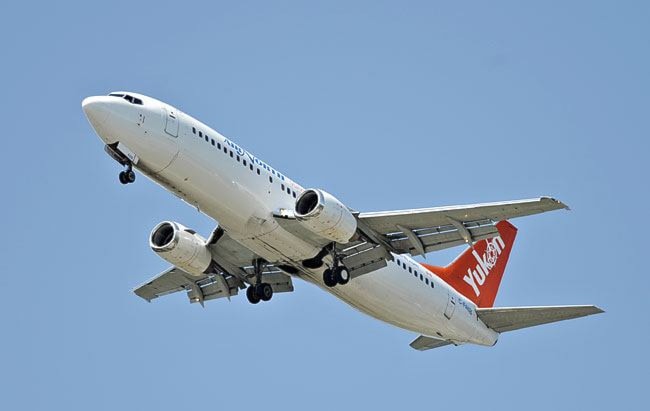Air North has a lot to recommend it as an airline, including friendly service, edible food, good prices and a lost-and-found centre just seven minutes from your house if your son forgets expensive electronics on the plane.
They also win hands-down in my recent informal survey of in-flight magazines. A great organization does the small things as well as the large, as Winston Churchill used to say.
Other in-flight magazines may have fancier glossy ads, or more bilingual profiles on pretentious Toronto restaurants, but Air North’s has what no other in-flight magazine has: an excellent economics section.
I’m talking about the regular letter from Joe Sparling, president of the airline. Rather than the usual CEO public relations drivel, Sparling’s letter is usually packed with facts about his airline and the industry as well as interesting perspectives on air travel.
Air travel is an important topic, if you happen to live in the northwest corner of a large continent a thousand miles from the nearest big city.
Sparling’s most recent charts on the economics of North American air travel are revealing. The industry looks at revenue and cost per available seat mile, or ASM - essentially the money they get from customers and their expenses, divided by the number of seats in the air and how far each one flew.
The top 10 carriers in North America average revenue per ASM of 14.6 cents, and cost per ASM of 14.5 cents. That produces a wafer-thin margin of just 0.1 cents per ASM, and explains why you keep reading about big American airlines going bankrupt.
Air North estimates, however, that the cost per ASM for its national competitors on the Whitehorse run are more than 16 cents, due partly to the cost of running smaller regional jets. Meanwhile, revenue is only 12 cents. That’s because the big carriers are running 40 per cent empty on the Whitehorse run, double the North American average. If these figures are correct, the big carriers are losing money on the Whitehorse run.
It is a classic competitive dogfight. Each airline is hoping to outlast the others, and benefit when prices go up after someone withdraws capacity. In the meantime, Air North estimates the price you pay per mile on Air North for Whitehorse-to-Vancouver travel is competitive with the major transcontinental routes and significantly cheaper than, say, Vancouver-Edmonton travel.
This underlines the benefits of competition. If you think fares to Vancouver would be as low if Canada had a single national airline, I have some swampland in Pelly Crossing I’d like to sell you.
But let’s think about the rest of the Yukon economy. How many other sectors are as bracingly competitive as air travel?
How many sectors have just one provider? How many choices do you have for telephone, electricity or Internet? How many sectors have the appearance of competition, but in the background the different brands are owned by the same interests? There are multiple cellphone brands, but your calls travel on the same network. Multiple local hotels are owned by the same investors, and both our movie theatres are in the same chain. And so on.
Then there are government services. How many choices do you have for mailing a letter? Having a baby or getting your broken arm fixed? Educating your children?
When you add it up, a significant portion of our economy is sheltered from competition to a significant degree.
The Soviets used to mock capitalist competition. Wouldn’t it be more efficient to have just one airline that ran at 95 per cent capacity, rather than several partially empty airplanes on the route?
But in practice, monopoly - whether private or public - often leads to inefficient practices and prioritization of the monopoly’s interests over the citizen’s.
Consider this thought experiment. Think of a poorly managed government department you know. What if you took their management team and put them in charge of Air North? It would make great reality TV as officials brought their management practices to Air North, doubling the size of head office, organizing multi-year strategic visioning processes, ignoring staff who bring up difficult issues, abolishing the customer satisfaction survey and so on.
The question would be whether the show could last a whole season before the bankruptcy lawyers showed up.
In real life, too many corporate and government leaders work in accountability-free zones. In the competitive environment with customer choice and bankruptcy lawyers, decisions have consequences and providers are more accountable for their performance.
Belief in the benefits of competition has spread widely, including some apparently unlikely places. The creation of the European single market, perhaps the biggest and most successful free-trade zone ever, was actually driven by French socialists like Jacques Delors and Francois Mitterand. European single-market competition law is among the toughest on the planet. Tony Blair of the U.K. Labour Party tried to inject more competition into public services, trying (not altogether successfully) to get hospitals and schools to compete with each other within the public sphere.
Even within the context of government services, smart policymakers inject competition where they can. The post office has a monopoly on letters, but not parcels. You can choose your family doctor. Whitehorse’s new independent elementary school, Yukon Montessori, is offering parents a new choice. They had an information session just last week.
As for Air North, the brutal truth is that Yukon customers will decide which airlines survive on the Vancouver run. Sparling’s letter wraps up by saying that “our team is dedicated to ensuring our product is the best in the market.” I’d say Air North is doing a great job delivering on that promise. And that it is probably because of the competition, rather than despite it.
Keith Halliday is a Yukon economist and author of the MacBride Museum’s Aurore of the Yukon series of historical children’s adventure novels.
